Aircraft Wing Design: 10 Types of Aircraft Wings (Complete Guide)
There is something that unifies all pilots together—an unwavering fascination with the wonder of flight and the multiple components that make everything possible. Among these components, aircraft wings stand out as a clear sign of the ingenuity of aeronautical engineering.
In this article, we will explore the diverse types of aircraft wings, delving into ten distinct designs that have left their mark on the history of aviation.
Ready fellow aviators? Let's dive in!

Featured Pilot Gear
Browse our selection of high-quality pilot supplies! Your purchase directly supports our small business and helps us continue sharing valuable aviation content.
There is something that unifies all pilots together—an unwavering fascination with the wonder of flight and the multiple components that make everything possible. Among these components, aircraft wings stand out as a clear sign of the ingenuity of aeronautical engineering.
The heart of any fixed-wing aircraft, the design and structure of these wings can greatly influence an aircraft's performance, maneuverability, and overall capabilities.
In this article, we will explore the diverse types of aircraft wings, delving into ten distinct designs that have left their mark on the history of aviation.
Ready fellow aviators? Let's dive in!
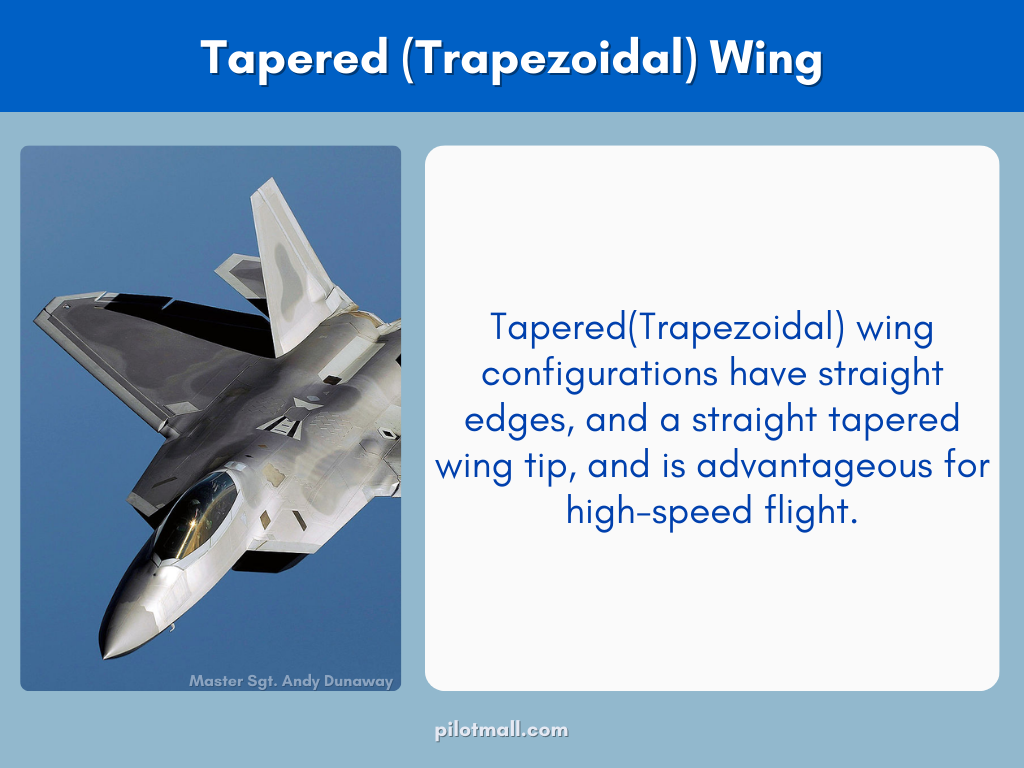
1. Tapered (Trapezoidal) Wing Design
The tapered wing is a slightly modified variation of the rectangular wing. Trapezoidal wing configurations have straight edges, and a straight tapered wing tips, and are advantageous for high-speed flight.
A tapered wing promotes low drag as well as superior durability during rapid air travel, so it was a popular choice in the early days of supersonic aircraft technology. This aerodynamic approach provided impressive performance and was implemented by several aircraft models.
Tapered Wing Aircraft:
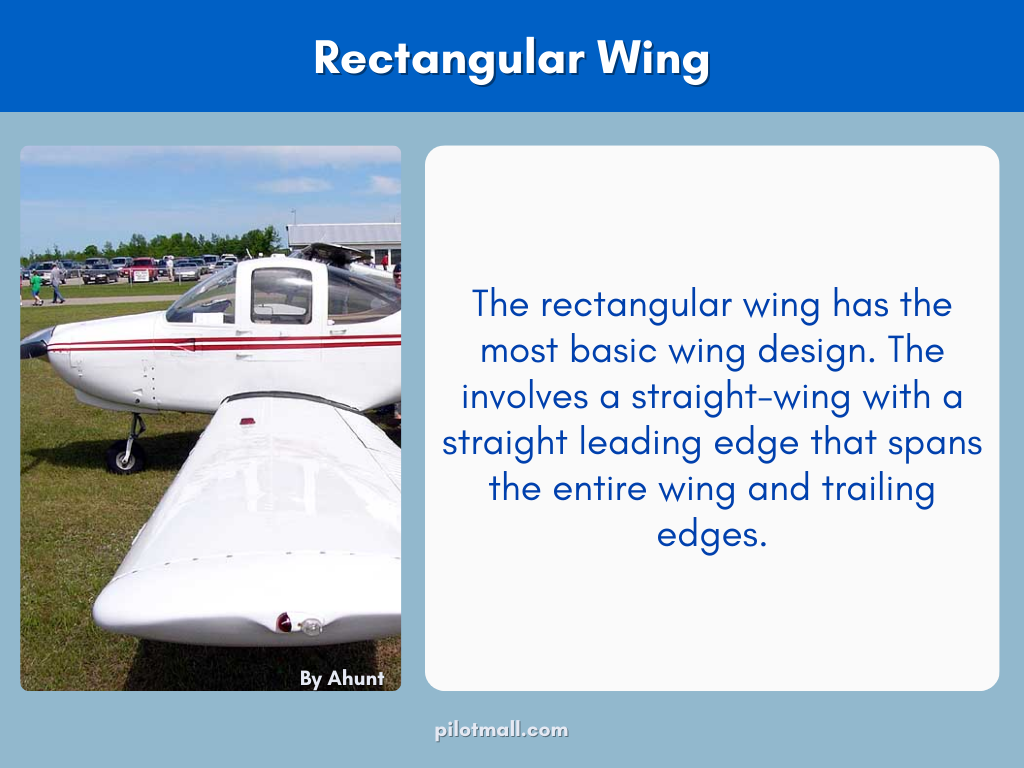
2. Rectangular Wing Design
The rectangular wing is one of the most basic wing configurations. This type of design involves a straight wing with a constant chord along a straight leading edge that spans the entire wing and trailing edges. A good example of a rectangular-wing aircraft is the Piper PA 38.
Is a Cessna 172 a Rectangular Winged Aircraft?
To a degree yes, but the wings on a Cessna 172 are not a perfect rectangle. Cessna aircraft have constant chord wings with a tapered outer section. It is considered a straight-wing design, almost rectangular, with a high-wing placement. However, they do have slight moderate tapering on the back side of the aircraft wing towards the wing tip.
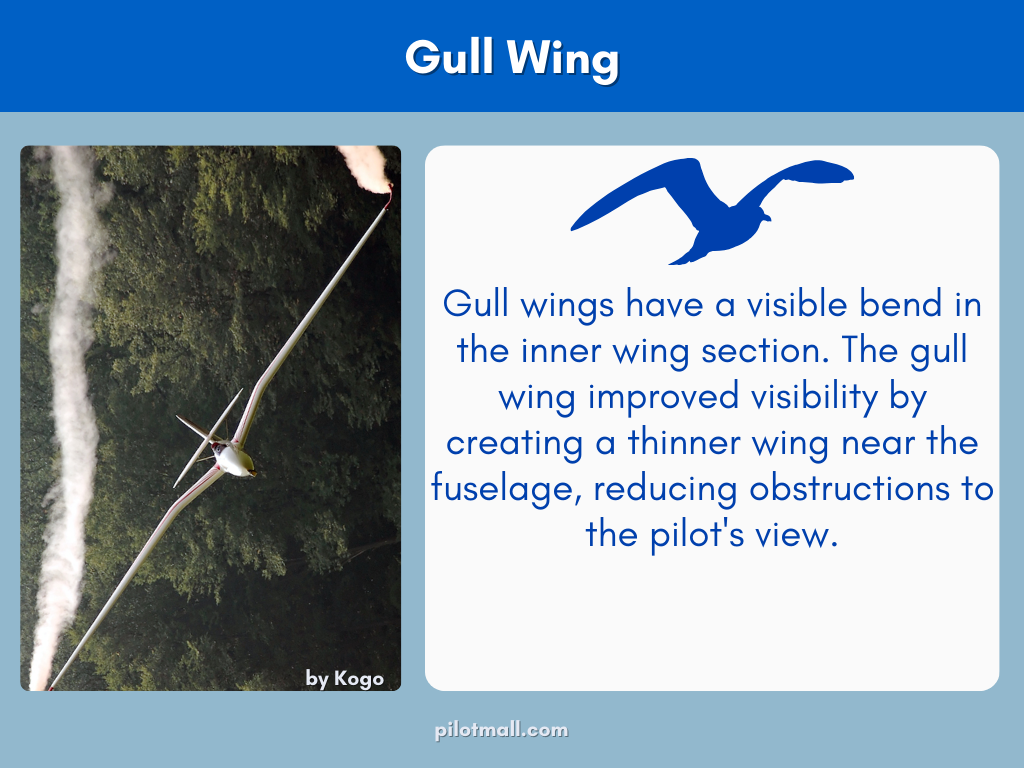
3. Gull Wing Design
The gull-wing configuration lives up to its name with the aircraft wings resembling a seagull's wing shape. The wings have a visible bend in the inner wing section.
The gull wing improved visibility by creating a thinner wing near the fuselage, reducing obstructions to the pilot's view. This wing configuration was first used on gliders, before being utilized on sailplanes and seaplanes as well.
Inverted gull wing
The inverted gull wing configuration was developed in the 1930s and was primarily used for single-engine military aircraft. It was felt that the use of an inverted gull wing meant that the landing gear could be shorter and allowed to retract back in straight uniformity.

4. Delta Wing Design
The delta wing is a design with the wings shaped into a triangle. The name of the design derives from the Greek letter delta (Δ). Delta wings are a wing configuration typically used in military aircraft due to their suitability for subsonic and supersonic aircraft flight when paired with jet engines. Also, due to its design, at low speeds delta wings require a high angle of attack to keep their lift.
Aircraft with Delta Wings
The delta wings are similar to a swept wing, with some of the most notable aircraft with delta wings being the Dassault Mirage III and the Avro Vulcan.
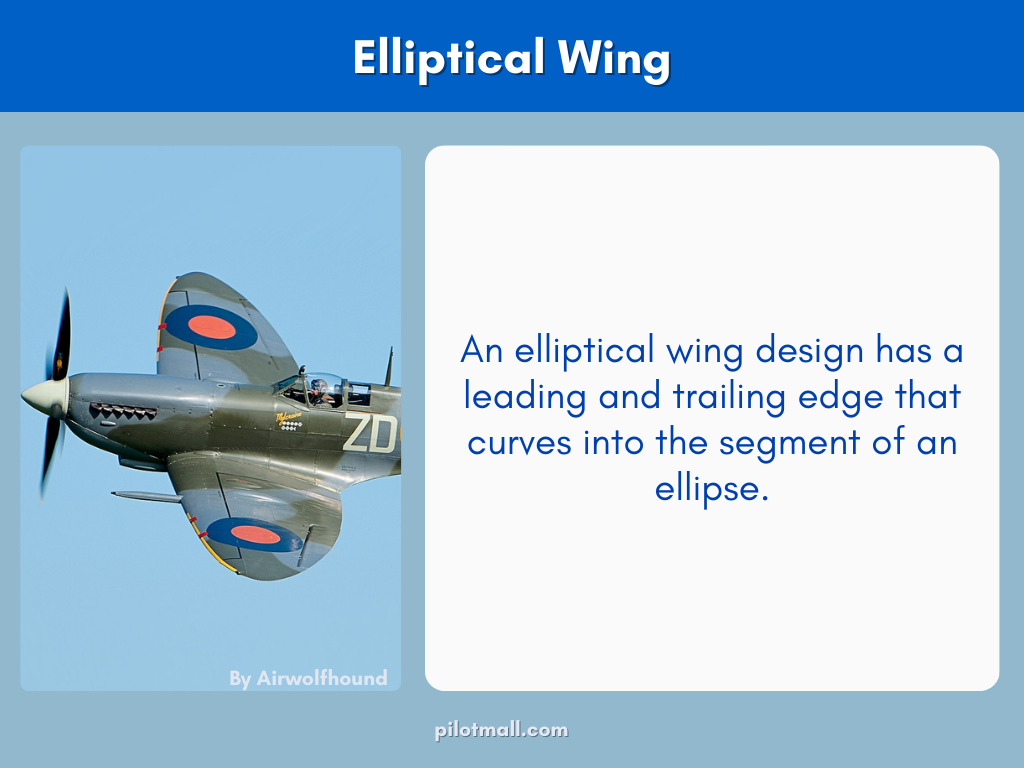
5. Elliptical Wing Design
An elliptical wing design has a leading and trailing edge that curves into the segment of an ellipse. A constant-elliptical wing can stall all at once due to the even lift distribution. Designers use an aerofoil with varied stall characteristics to give pilots more warning.
Elliptical Wing Aircraft:
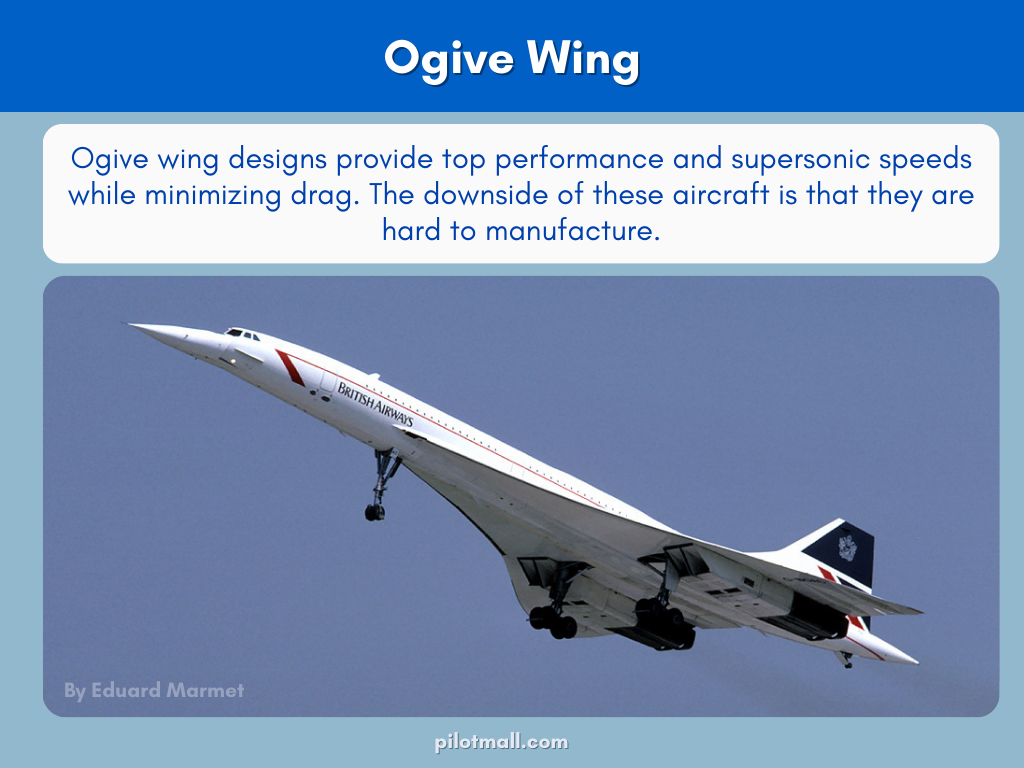
6. Ogive Wing
Ogive wing designs provide top performance and supersonic speeds while minimizing drag. The downside of these aircraft is that they are hard to manufacture.
Ogive Wing Aircraft
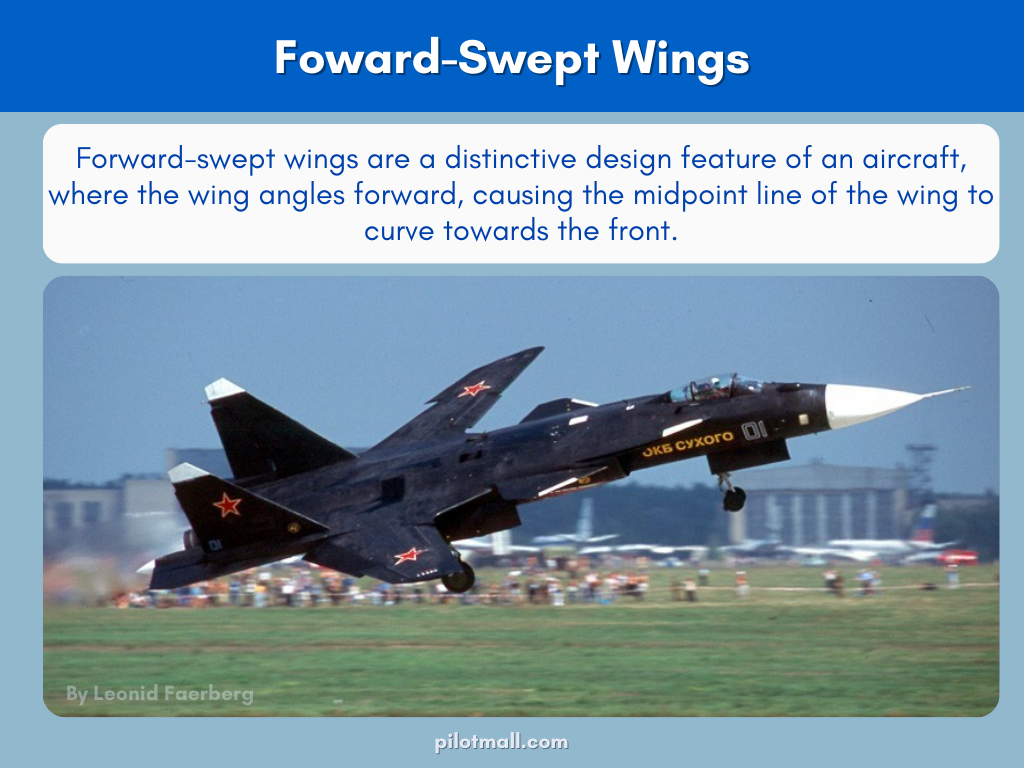
7. Forward-Swept Wings
A forward-swept wing has a distinctive design feature of an aircraft, where the wing angles forward, causing the midpoint line of the wing to curve towards the front.
Forward-Swept Wing Aircraft
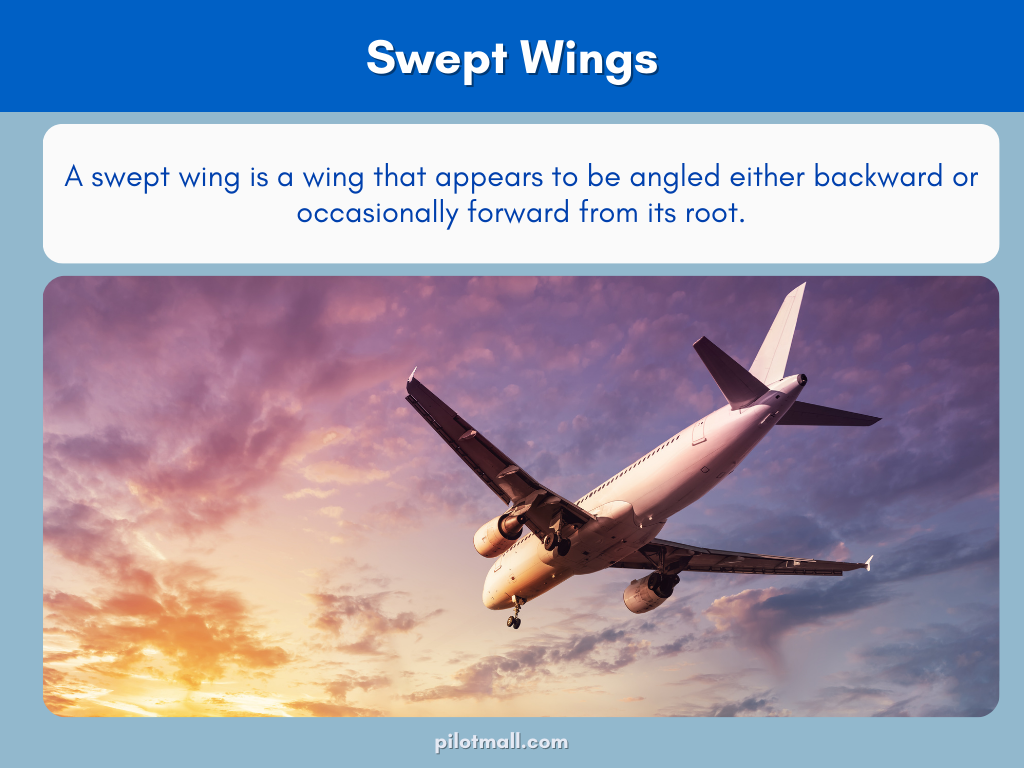
8. Swept Back Wings
Swept-back wings are wings that appear to be angled either backward or occasionally forward from their root. Rather than protruding sideways in a straight line, the wings seem to angle and have a more aerodynamic appearance.
There are drawbacks of this wing, when a swept wing travels at high speeds, the airflow flows over the wing with little reaction time and goes almost straight from the front to the back.
Many commercial aircraft have swept wings due to the fact that they reduce turbulence. The design slows down the air that travels across the wings' surface.
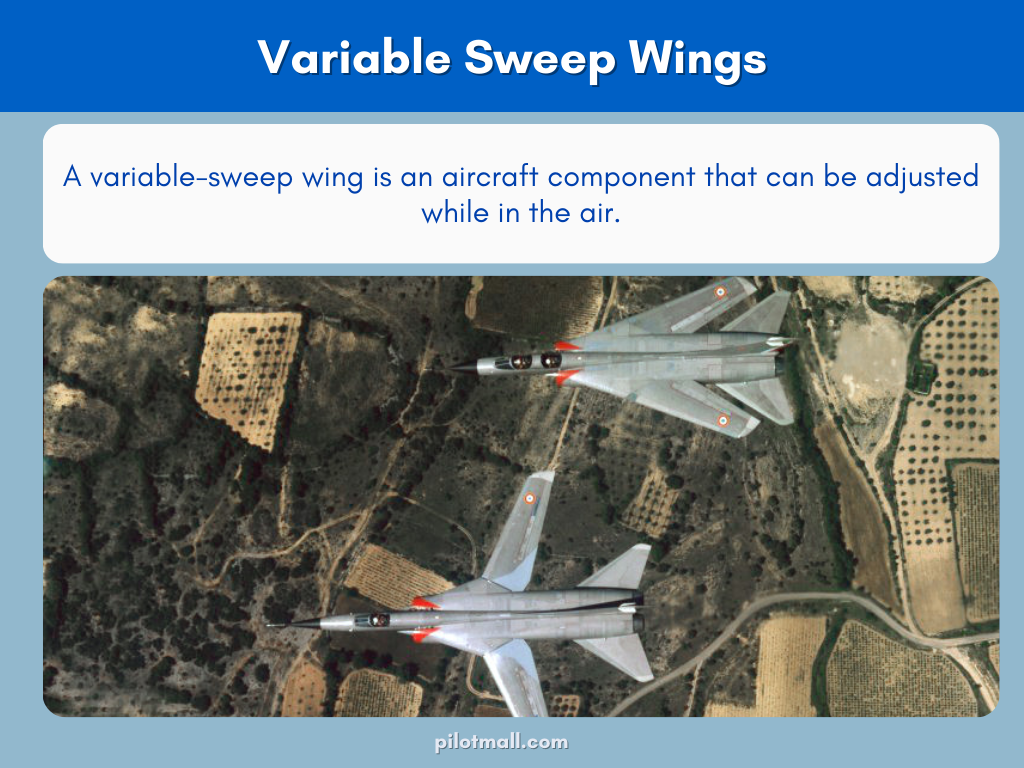
9. Variable Sweep Wings
A variable-sweep wing is an aircraft component that can be adjusted while in the air. Its wingspan can be changed from straight to swept back, and vice versa, during flight. This alteration of shape allows for greater control and aerodynamic efficiency.
Variable Sweep Wing Aircraft

10. Oblique Wing
An oblique wing is an airplane wing design with the ability to change shape. The wing has a central hinge which, when rotated, sweeps one end of the wing forward while pushing the other end back.
Oblique Wing Aircraft

Other Wing Configurations
There is much more to aircraft wings than simply their shape, their positioning can also come into play. There are close to 35 different types of wing configurations and you might see some modern aircraft combining the different types together.

High Wing
High wings are wings that are mounted on the upper part of the fuselage. An example of an aircraft that includes the high wing configuration are Cessnas. The advantage of this wing placement is that it provides an unobstructed view below, ideal for aerial photography.
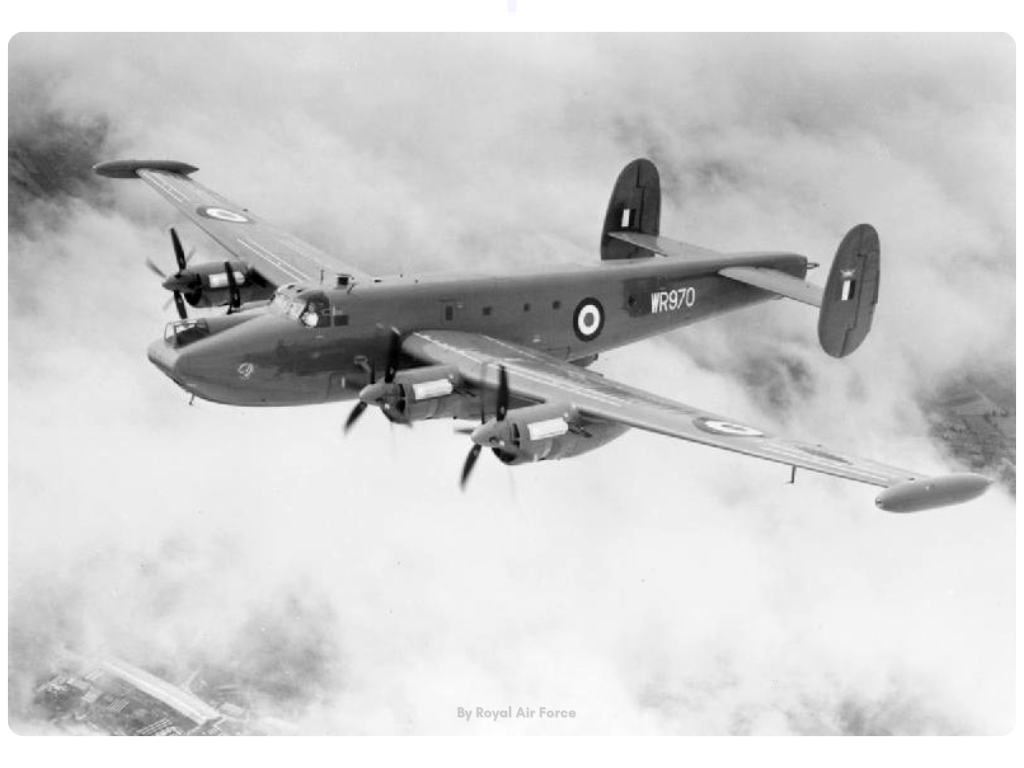
Mid Wing
A mid-wing configuration is when the wings are mounted on the midsection of the fuselage. This mid-wing design affects how much usable space is within the fuselage.

Low Wing
The low-wing structure is the most used design in the single-engine general aviation world. The wings are located low onto the aircraft's fuselage. This helps to create an unobstructed view of the sides and ahead. Low-wing airplanes most pilots become very familiar with typically include Piper aircraft.
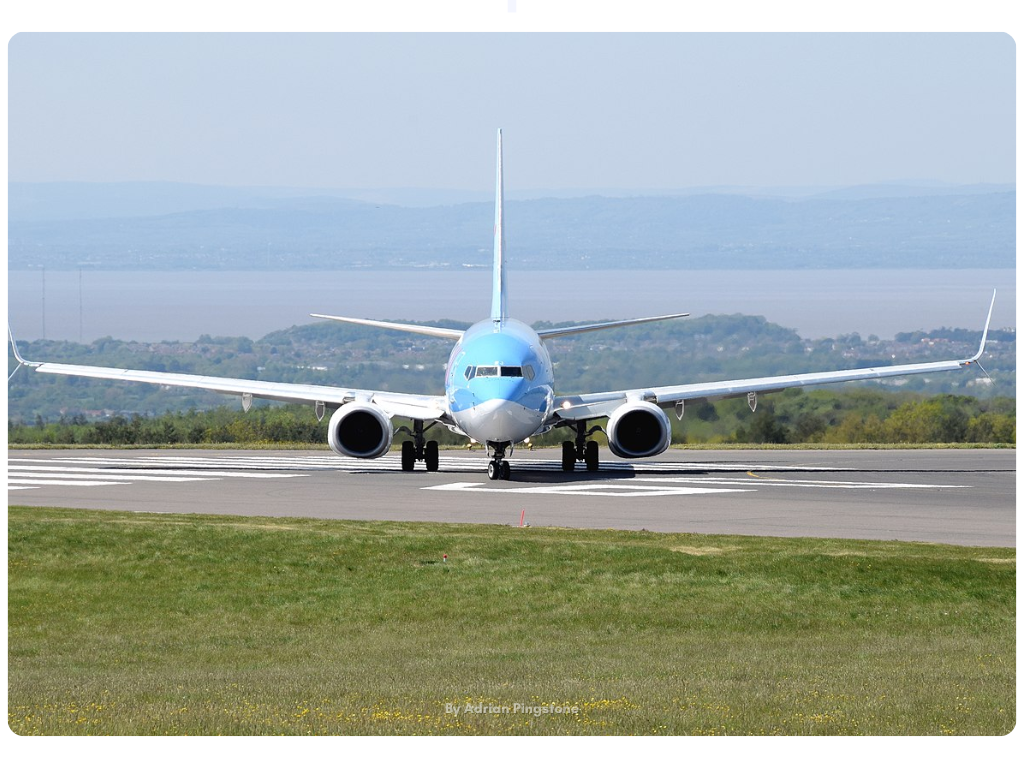
Dihedral Wing
The Dihedral wing configuration involves a wing that is angled upward from the horizontal of the wings or tailplane of a fixed-wing aircraft. To simplify this explanation, a dihedral wing looks like it is slightly tilted upward.
Anhedral Wing
An Anhedral wing configuration is the opposite of the dihedral, the wings tilt downward with this wing design.

Frequently Asked Questions
- Why do most commercial airliners use swept-back wings?
- Swept-back wings delay the onset of shock waves at high speeds (transonic speeds), which reduces drag and allows the aircraft to fly faster and more efficiently.
- What is the advantage of a high wing vs. a low wing?
- High-wing aircraft generally offer better ground visibility and stability due to the pendulum effect, while low-wing aircraft often provide better visibility above and can be easier to refuel.
- What is the purpose of winglets?
- Winglets are vertical extensions at the wingtips that reduce induced drag by minimizing wingtip vortices, improving fuel efficiency and range.
- Do all wings generate lift the same way?
- While the fundamental principle of creating a pressure difference (Bernoulli's principle) and deflecting air downward (Newton's third law) applies to all, the efficiency and handling characteristics at different speeds vary greatly depending on the wing shape.
Takeaway
The combinations and configurations of aircraft wings are endless, and what a wonderful thing that is. Every wing shape has its purpose and place in the sky, crafted with a unique design to meet whatever goals pilots have for their aircraft.
To take flight is to transcend the mundane of earthbound life, breaking the bonds of gravity with each thrust of an engine. Such beauty can be found in the sky, a constantly shifting landscape that rewards those brave enough to venture into it.
As pilots, our biggest asset is knowledge. We must always be exploring and learning more about the craft of flying.
Push yourself to try something new every day; whether it's a complex maneuver or a new airspace concept, take on those challenges with enthusiasm.
And most importantly, never forget why you fly: to enjoy the beauty of flight itself! So, thank you for taking the time to read this guide.
Fly well, my friends.
Enjoy learning about the types of aircraft wings?
Check out these guides for more useful aircraft wing design-related subjects.
- 10 Different Types of Airplane Flaps (Photos Included)
- High Wing vs Low Wing: What’s the Difference Between Them?
- 7 Types of Airplane Drag That Affect Your Plane
Did you find this article helpful?
Do you think we missed anything important? Let us know in the comments below!








